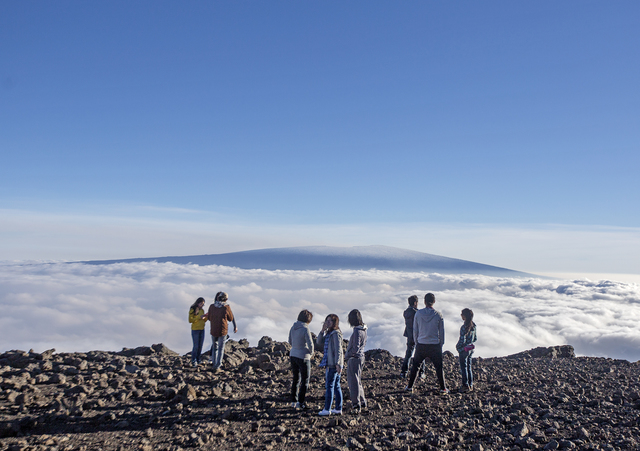While the Mauna Kea Access Road was built a half century ago with only astronomy in mind, observatory and University of Hawaii staff today account for about 20 percent of traffic to the summit, according to Mauna Kea Observatories Support
While the Mauna Kea Access Road was built a half century ago with only astronomy in mind, observatory and University of Hawaii staff today account for about 20 percent of traffic to the summit, according to Mauna Kea Observatories Support Services.
The office, which operates under the University of Hawaii at Manoa’s Institute for Astronomy, recently installed a traffic counter above Halepohaku that is providing the first data on use of the state’s tallest mountain.
According to Mauna Kea support services, 4,695 vehicles were counted in May, with about 940 being attributed to UH and telescope operators, who drive vehicles equipped with radio tags that allow them to be closely tracked.
The remaining 3,755 vehicles were associated with either tourism, cultural and recreational use, or a few contractors who haven’t yet been equipped with the radio tags, officials said.
While the effort to track traffic to the summit is still new and lacks historical data, UH spokesman Dan Meisenzahl said visitor counts at the Mauna Kea Visitor Information Station just below Halepohaku at 9,200 feet show that tourism has been increasing significantly on the mountain over the past few years.
He said a likely factor is completion of improvements to Saddle Road that have allowed for easier access.
“You couldn’t take your rental car there before,” Meisenzahl said.
Mauna Kea support services estimates 300,000 people stopped at the visitor center last year, up from 200,000 in 2010 and 100,000 in 2003.
Public access, and how that should be managed, will be part of the discussion at open houses the Office of Mauna Kea Management is hosting this week regarding new administrative rules.
A survey conducted by the UH-Hilo Sociology Department in 2012 estimated about 20 percent of people stopping at the visitor center were from the Big Island. Mainland visitors accounted for about 54 percent of those surveyed, while about a third of participants were international travellers.
Eight commercial tour companies have permits to operate on the mountain. Each are restricted to two 14-passenger vans per day.
Meisenzahl said no more permits are being processed until the administrative rules process is complete.
Revenue from the permits helps pay for the management office’s share of road maintenance and visitor station costs.
For fiscal year 2015-2016, which starts July 1, Mauna Kea support services has budgeted $527,919 to maintain the 8.5 miles of road above Halepohaku.
That includes a 4.7-mile unpaved section that is graded twice a week. Another $158,875 is set aside for snow clearing.
The 13 observatories on the mountain cover the snow removal budget and about 82 percent of the road maintenance expenses. The Mauna Kea management office contributes the remaining 18 percent, or $95,025, for road work.
While its construction remains paused, the Thirty Meter Telescope also is making contributions for road clearing and maintenance that will total $85,389 during the next fiscal year, more than any of the existing telescopes. Its contributions started last October.
How much observatories pay depends on their size and other factors. At 180 feet tall, TMT will be the largest observatory on the mountain.
The observatories also cover nearly all of the visitor station’s budget shortfall, estimated at $371,500 for this next fiscal year, and the $280,825 budget for the Mauna Kea weather station, according to Mauna Kea support services.
The Mauna Kea management office’s open house meetings are scheduled for Tuesday at West Hawaii Civic Center, Wednesday at ‘Imiloa Astronomy Center in Hilo, and Thursday at the Department of Hawaiian Home Lands’ West Hawaii district office in Waimea. They each last from 5-7:30 p.m.
Email Tom Callis at tcallis@hawaiitribune-herald.com.



